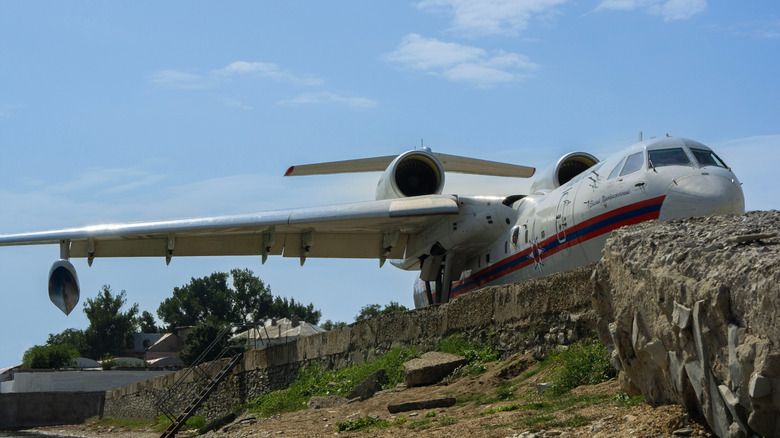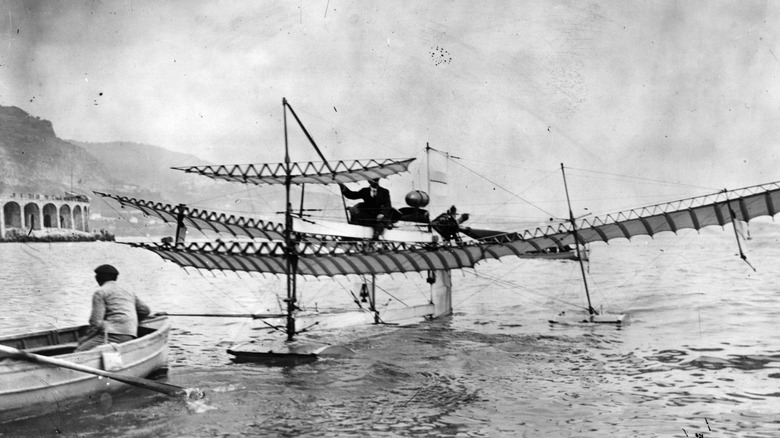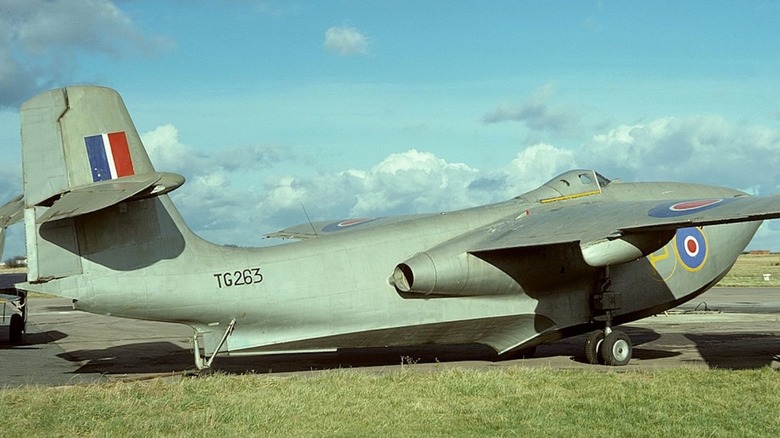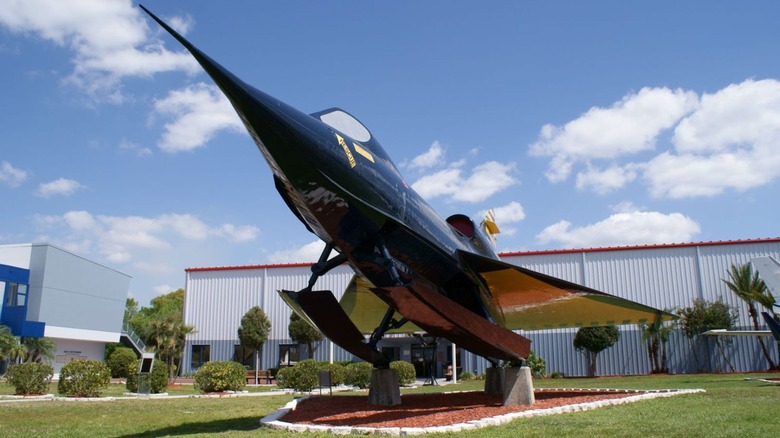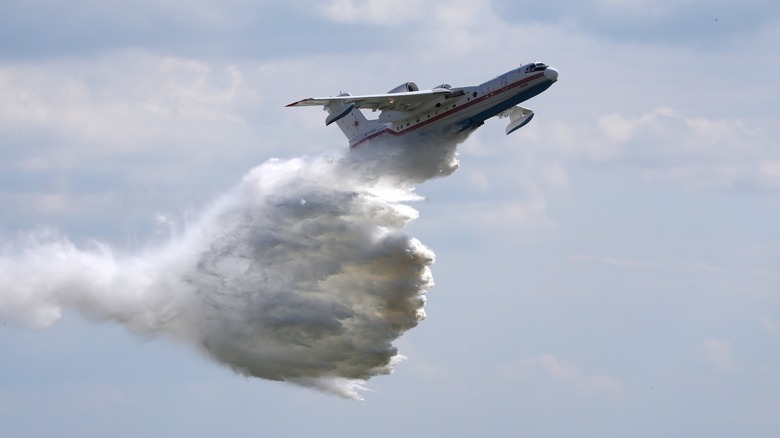Were Jet-Powered Seaplanes Ever Built?
When you think about seaplanes, the last thing that comes to mind is a variant powered by jet propulsion. You never see jet-powered seaplanes on lists of the most iconic planes in history, and they're seldom mentioned when the history of the jet age is discussed. In fact, they may seem to exist only in James Bond-esque movies. But a few of them have actually been built.
One of the most renowned jet-propelled seaplanes is the Saunders-Roe SR.A/1, considered the world's first jet-powered seaplane. Another is the Convair Sea Dart, a seaplane jet fighter that rode on hydro-skis while taking off or landing. Last but not least is the Beriev Be-200, a multi-role seaplane that features jet propulsion and is still in use today.
These aircraft are a testament to aviation innovation, but even though they were impressive in their time — and even today — few stayed long enough to make a name for themselves. Let's explore this niche corner of aviation and some of the best-known jet-powered seaplanes.
The birth of the seaplane
In 1903, the first powered plane took to the sky. Just seven years later, French aviator Henri Fabre's Hydravion became the first seaplane to successfully take off from water.
Fabre, whose family owned ships, had been in love with flying since his younger years. While undertaking his engineering education at the Jesuit College of Marseilles, France, he met a founding member of the Aero-Club de France, Ernest Archdeacon, a meeting that would cement his future in aviation. By 1906, Fabre was building the Hydravion, which would be flight-ready only four years later.
The Hydravion took flight at Martigues, near Marseilles. Fabre had fashioned it out of plywood and ash wood, with the former making up the craft's floats while the latter made up its frame. The Hydravion's frame had cotton coverings, and its wingspan measured 45 feet, 11 inches while its length came in at 27 feet, 10 inches.
Fabre's success opened the door to an ocean of possibilities, and some 20 years later, seaplanes had cemented their spot among the world's most reliable and largest aircraft. It would only be a matter of years before the first jet-powered seaplane took flight.
The concept that never flew far
The Saunders-Roe SR.A/1 was the first seaplane powered by jet propulsion to take to the sky. Saunders-Roe, a British engineering company with expertise in the marine and aviation worlds, presented the prototype's design: a boat-hull-based plane with two Metropolitan-Vickers Beryl turbojet engines.
The plane was meant to operate in the Pacific without needing an aircraft carrier or large airfields to take off or land. Its length was 50 feet, its wingspan 46 feet and its height was 16 feet, 9 inches. By July 1947, a prototype was clearing test flights with promising results. However, it would only be a matter of time before a string of design challenges cropped up.
Key among these issues was the plane's weight, resulting from its hefty hull and engines. The SR.A/1 was essentially a fighter jet meant to contend with other jets in airborne fights. Its weight made it slower and more challenging to control than its competition, leaging it functionally inferior. To add insult to injury, the Beryl engines were unreliable and needed too much maintenance. By the end of the SR.A/1's run in the early 1950s, only three prototypes had ever been made.
A supersonic seaplane on hydro-skis
Toward the end of the SR.A/1's uneventful era, the U.S. Navy gave Convair an order for an unusual jet-powered seaplane. The Navy had been looking into water-based supersonic planes that could be deployed anywhere in the world, and had asked for proposals for such aircraft in 1948. Its order to Convair called for two such planes, each sporting twin hydro-skis, and in 1951, Convair's engineers started building them.
The aircraft manufacturer finished the Sea Dart in just two years, unveiling a plane measuring 51 feet 1.5 inches long, standing 17 feet tall, with a wingspan of 33 feet 8 inches. This first Sea Dart (Convair would build four more down the road) had twin Westinghouse J34-WE-32 engines meant to hurl it past the supersonic line. The craft was designated XF2Y-1 and made its maiden flight in April 1953 over San Diego Bay.
The Navy had high expectations of the Sea Dart, and just a year after its first flight, the plane hit its first and only supersonic speed. However, despite this, the Sea Dart would meet its end in 1957 due to several unfortunate circumstances, including a lack of funding and a heartbreaking 1954 crash, on live TV, that claimed the life of its test pilot.
A jet-powered firefighter
The Beriev Be-200, built by the Berieva Aviatsionnyi Kompaniya (Beriev Aviation Company), is similar to the SR.A/1 in that its fuselage is constructed like the hull of a ship. Built in 1998, this Russian jet-powered seaplane has a wingspan of 107.5 feet, a length of 103.2 feet, and a height of 29.2 feet. Unlike the SR.A/1, which was created as a fighter jet, the Be-200 is a multirole craft, with one of its initial intended roles being a firefighter.
Yes, Beriev built the Be-200 as a seaplane focused on carrying tons of water to quell raging fires. However, the it can take on the role of a passenger craft, as is seen in its variant, the Be-210. It can also be used as a freighter, a search and rescue craft, or even an ambulance. Although the Be-200 is still in use today, the plane's production has hit a snag due to engine supply problems attributed to Russia's ongoing war in Ukraine.
